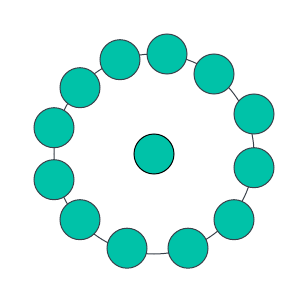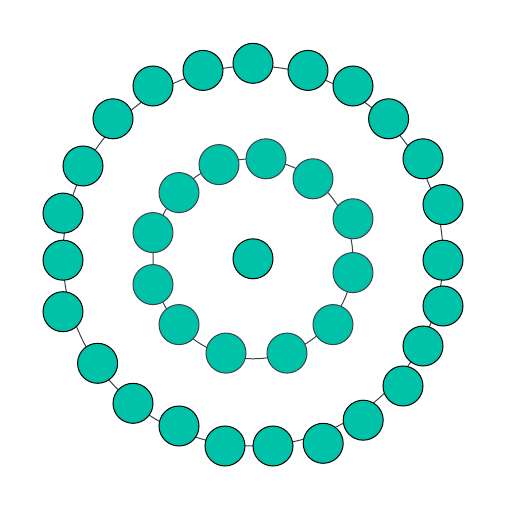central dodecagon number
The graphic numbers depicting a dodecagon are called dodecagonal numbers. The central dodecagon number is represented by a point at the center and other points surrounding that point in a layer of continuous dodecagons (that is, 12-sided polygons).
The central dodecagon number can be better explained by the following diagram.

For n=1, there is only one point in the center. So the output is 1.

For n=2, there is a point in the center surrounded by a dodecagon. Therefore, the total number of points will be 13. So the next central dodecagon number will be 13.

For n=3, there will be a single point in the center, followed by a dodecagon surrounding it, and then the next consecutive layer of dodecagons containing 24 points. Therefore, the total number of points will be 37, which will be the next central dodecagon number.
Similarly, this will be followed for every positive number n. Referring to this, the first few dodecagon numbers will be 1, 13, 37, 73, 121, 181…..
In this problem, we will be given any positive number n and need to print the nth central dodecagon number.
For example,
Enter - 2
Output - 13
Enter - 5
Output - 121
The following is the algorithm to solve this problem.
algorithm
To calculate the nth central dodecagon number, we need to figure out the pattern followed in the problem.
According to the concept of central dodecagon number, it is represented by a point in the center, followed by successive layers of dodecagons. The successive layers of dodecagons are 12, 24, 36, 48... If we look closely at the pattern, it forms an arithmetic sequence with a tolerance of 12.
Since the first few sequences of central dodecagon numbers are 1, 13, 37, 73…. It is nothing more than the sum of the dodecagon layers and a point in the center.
We can understand it better if we consider a sequence of consecutive dodecagonal layers starting with 0.
0, 12, 24, 36, 48. For n=1, the centred dodecagonal number is 1 which is 0+1. For n=2, the centred dodecagonal number is 13 which is 0+12+1. For n=3, the centred dodecagonal number is 37 which is 0+12+24+1.
From here we can think that the nth central dodecagon number is nothing but the sum of A.P. of n terms starting from 0, with the tolerance being 12 and 1.
So the formula of the nth central dodecagon number can be expressed as,
$$\mathrm{CDn=arithmetic sequence (a=0\:and\:d=12)\:the first n\:terms and\:1}$$
$$\mathrm{CD_n\:=\:\frac{n}{2}(2a\: \:(n-1)d)\: 1}$$
Here, $\mathrm{CD_n}$ is the nth central dodecagon number
a is the first term of the arithmetic sequence, which is 0
d is the tolerance of the arithmetic sequence, which is 12
Further, the formula can be written as:
$$\mathrm{CD_n\:=\:\frac{12n}{2}(n-1)\: \:1}$$
$$\mathrm{CD_n\:=\:6n(n-1)\: \:1}$$
Keep the original text without translationWe will use the above formula to calculate the nth central dodecagon number in our method.
method
To solve this problem, we simply create a function to calculate the nth central dodecagon number.
We will use the derived formula above to calculate the nth central dodecagon number for any n positive numbers.
Return the calculated value, which will be our desired output.
Example
is:Example
The following is the implementation of the above method in C -
#include <iostream>
#include<bits/stdc++.h>
using namespace std;
//function to calculate the nth centred dodecagonal number
int CDn(int N){
int ans= 6 * N * (N-1) + 1; //used to store nth centred dodecagonal number value
return ans; //return the answer
}
int main(){
int N=8;
cout<<CDn(N)<<endl;
N=6;
cout<<CDn(N)<<endl;
N=12;
cout<<CDn(N)<<endl;
return 0;
}
Output
337 181 793
Time complexity: O(1), because constant time is required.
Space Complexity: O(1), because we don’t take up any extra space.
in conclusion
In this article, we solve the problem of printing the nth centered dodecagon number. We learned the concept of centered dodecagon numbers and derived the formula for the nth number,
I hope you found this article helpful in understanding and clarifying all the concepts regarding this issue.
The above is the detailed content of central dodecagon number. For more information, please follow other related articles on the PHP Chinese website!

Hot AI Tools

Undresser.AI Undress
AI-powered app for creating realistic nude photos

AI Clothes Remover
Online AI tool for removing clothes from photos.

Undress AI Tool
Undress images for free

Clothoff.io
AI clothes remover

AI Hentai Generator
Generate AI Hentai for free.

Hot Article

Hot Tools

Notepad++7.3.1
Easy-to-use and free code editor

SublimeText3 Chinese version
Chinese version, very easy to use

Zend Studio 13.0.1
Powerful PHP integrated development environment

Dreamweaver CS6
Visual web development tools

SublimeText3 Mac version
God-level code editing software (SublimeText3)

Hot Topics
 1378
1378
 52
52
 C language data structure: data representation and operation of trees and graphs
Apr 04, 2025 am 11:18 AM
C language data structure: data representation and operation of trees and graphs
Apr 04, 2025 am 11:18 AM
C language data structure: The data representation of the tree and graph is a hierarchical data structure consisting of nodes. Each node contains a data element and a pointer to its child nodes. The binary tree is a special type of tree. Each node has at most two child nodes. The data represents structTreeNode{intdata;structTreeNode*left;structTreeNode*right;}; Operation creates a tree traversal tree (predecision, in-order, and later order) search tree insertion node deletes node graph is a collection of data structures, where elements are vertices, and they can be connected together through edges with right or unrighted data representing neighbors.
 The truth behind the C language file operation problem
Apr 04, 2025 am 11:24 AM
The truth behind the C language file operation problem
Apr 04, 2025 am 11:24 AM
The truth about file operation problems: file opening failed: insufficient permissions, wrong paths, and file occupied. Data writing failed: the buffer is full, the file is not writable, and the disk space is insufficient. Other FAQs: slow file traversal, incorrect text file encoding, and binary file reading errors.
 How do I use rvalue references effectively in C ?
Mar 18, 2025 pm 03:29 PM
How do I use rvalue references effectively in C ?
Mar 18, 2025 pm 03:29 PM
Article discusses effective use of rvalue references in C for move semantics, perfect forwarding, and resource management, highlighting best practices and performance improvements.(159 characters)
 What are the basic requirements for c language functions
Apr 03, 2025 pm 10:06 PM
What are the basic requirements for c language functions
Apr 03, 2025 pm 10:06 PM
C language functions are the basis for code modularization and program building. They consist of declarations (function headers) and definitions (function bodies). C language uses values to pass parameters by default, but external variables can also be modified using address pass. Functions can have or have no return value, and the return value type must be consistent with the declaration. Function naming should be clear and easy to understand, using camel or underscore nomenclature. Follow the single responsibility principle and keep the function simplicity to improve maintainability and readability.
 How do I use ranges in C 20 for more expressive data manipulation?
Mar 17, 2025 pm 12:58 PM
How do I use ranges in C 20 for more expressive data manipulation?
Mar 17, 2025 pm 12:58 PM
C 20 ranges enhance data manipulation with expressiveness, composability, and efficiency. They simplify complex transformations and integrate into existing codebases for better performance and maintainability.
 How to calculate c-subscript 3 subscript 5 c-subscript 3 subscript 5 algorithm tutorial
Apr 03, 2025 pm 10:33 PM
How to calculate c-subscript 3 subscript 5 c-subscript 3 subscript 5 algorithm tutorial
Apr 03, 2025 pm 10:33 PM
The calculation of C35 is essentially combinatorial mathematics, representing the number of combinations selected from 3 of 5 elements. The calculation formula is C53 = 5! / (3! * 2!), which can be directly calculated by loops to improve efficiency and avoid overflow. In addition, understanding the nature of combinations and mastering efficient calculation methods is crucial to solving many problems in the fields of probability statistics, cryptography, algorithm design, etc.
 How do I use move semantics in C to improve performance?
Mar 18, 2025 pm 03:27 PM
How do I use move semantics in C to improve performance?
Mar 18, 2025 pm 03:27 PM
The article discusses using move semantics in C to enhance performance by avoiding unnecessary copying. It covers implementing move constructors and assignment operators, using std::move, and identifies key scenarios and pitfalls for effective appl
 How does dynamic dispatch work in C and how does it affect performance?
Mar 17, 2025 pm 01:08 PM
How does dynamic dispatch work in C and how does it affect performance?
Mar 17, 2025 pm 01:08 PM
The article discusses dynamic dispatch in C , its performance costs, and optimization strategies. It highlights scenarios where dynamic dispatch impacts performance and compares it with static dispatch, emphasizing trade-offs between performance and




